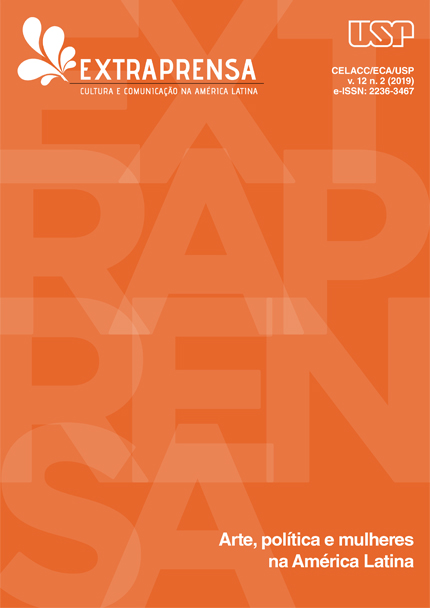Pregnancy and childbirth in the trailer work of Nicola Costantino
DOI:
https://doi.org/10.11606/extraprensa2019.157643Keywords:
Contemporary Art, Pregnancy, Birth, FeminismAbstract
The objective of this article is to analyze the representation of pregnancy and childbirth in the work Trailer, by Nicola Costantino. The initial hypothesis is that since the advent of feminism representations of motherhood that question patriarchy have been introduced in contemporary art. In the particular case of pregnancy and giving birth, since modern times, they have been appropriated by the male order. The medicinal discourse and the disciplining of the female body has taken from women the domination over our own pregnancies, censoring experiences and practices transmitted ancestrally among women. Faced with this scenario, our work attempts to observe how contemporary art continues to promote the dominance of this patriarchal order or questions it, producing new possibilities to conceive pregnancy and childbirth promoting the social transformation that this implies.
Downloads
References
AMORÓS, Celia. Hongos hobbesianos, setas venenosas. Mientras Tanto, Barcelona, n. 48, p. 59-68, 1992.
BARTHES, Roland; BOONS, Marie-Claire; BURGELIN, Olivier; GENETTE, Gerard; GRITTI, Jules; KRISTEVA, Julia; METZ, Christian; MORIN, Violette; TODOROV, Tzvetan. Lo verosímil. Buenos Aires: Tiempo Contemporáneo, 1970.
FREUD, Sigmund. Lo ominoso. In: FREUD, Sigmund. Obras Completas. Buenos Aires: Amorrortu, 2009. v. 17, p. 215-251.
LOBO POLIDANO, Esther. El doble y su relación con lo siniestro. L’aperiòdic virtual de la Secció Clínica de Barcelona, Barcelona, n. 30, p. 1-13, 2010. Disponible en: https://bit.ly/2YyuTyQ. Acceso en: 26 nov. 2018.
RODRIGÁÑEZ BUSTOS, Casilda. Pariremos con placer: apuntes sobre la recuperación del útero espácito y la energía sexual femenina. Buenos Aires: Madreselva, 2007.
SAU, Victoria. Del vacío de la maternidad, la igualdad y la diferencia. Vía Fora!!, Barcelona, n. 55, p. 61-75, 1997.
SAU, Victoria. El vacío de la maternidad: madre no hay más que ninguna. Barcelona: Icaria, 2004.
SEGRE, Cesare. Tema/motivo. In: SEGRE, Cesare. Principios de análisis del texto literario. Barcelona: Crítica, 1985. p. 339-366.
VERÓN, Eliseo. La semiosis social. Barcelona: Gedisa, 1987.
VERÓN, Eliseo. La semiosis social 2: ideas, momentos, interpretaciones. Buenos Aires: Paidós, 2013.
Downloads
Published
Issue
Section
License
Ao submeter qualquer material científico para Extraprensa, o autor, doravante criador, aceita licenciar seu trabalho dentro das atribuições do Creative Commons, na qual seu trabalho pode ser acessado e citado por outro autor em um eventual trabalho, porém obriga a manutenção de todos os autores que compõem a obra integral, inclusive aqueles que serviram de base para o primeiro.
Toda obra aqui publicada encontra-se titulada sob as seguintes categorias da Licença Creative Commons (by/nc/nd):
- Atribuição (de todos os autores que compõem a obra);
- Uso não comercial em quaisquer hipóteses;
- Proibição de obras derivadas (o trabalho não poderá ser reescrito por terceiros. Apenas textos originais são considerados);
- Distribuição, exibição e cópia ilimitada por qualquer meio, desde que nenhum custo financeiro seja repassado.
Em nenhuma ocasião a licença de Extraprensa poderá ser revertida para outro padrão, exceto uma nova atualização do sistema Creative Commons (a partir da versão 3.0). Em caso de não concordar com esta política de Direito Autoral, o autor não poderá publicar neste espaço o seu trabalho, sob pena de o mesmo ser removido do conteúdo de Extraprensa.







